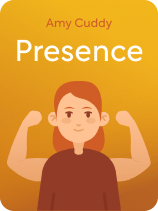

This article is an excerpt from the Shortform book guide to "Presence" by Amy Cuddy. Shortform has the world's best summaries and analyses of books you should be reading.
Like this article? Sign up for a free trial here.
Is your mind burdened by self-doubt in front of others? How can you have presence?
According to Amy Cuddy, “presence” is having faith in your abilities and feeling comfortable in your own skin, which naturally leads to an easy, confident mindset. She adds in her book Presence that when you embody presence, you exhibit agency over your self-expression.
Find out how to have presence and remove a negative mindset.
How to Increase Your Presence
A key to presence is good self-esteem and clarity about your identity, and Cuddy says that one way to know how to have presence is by affirming your strengths and what’s most important to you by writing down or reflecting on these elements before you enter a challenging situation. The reminder of your priorities and strengths will reduce your fear of being rejected and put you at ease because you’re reassured by your positive opinion rather than speculating about what others may think.
(Shortform note: Cuddy’s concept of achieving presence by affirming your strengths and priorities is similar to other authors’ advice for cultivating confidence. For example, in High Performance Habits, Brendon Burchard says that to be confident you must have a clear self image so that you can then decisively pursue that vision. He says you can acquire this trait—what he calls “congruence”—by defining your values and setting intentions before you begin an endeavor. Burchard’s other two attributes of confidence include interpersonal connection (which presence also encourages), and competence (which Cuddy doesn’t include as a prerequisite for presence).)
The other major component of Cuddy’s advice hinges on the link between your mind and body and the idea that you can improve your mindset by changing your body language. She explains that the body-mind link is two-way: For example, when you feel embarrassed, your face flushes red—a physical response to the emotion. But when you change your posture to exude confidence—by relaxing your shoulders, for instance—your emotions also take cues from your body, and you start to genuinely feel more at ease.
(Shortform note: Because of this two-way connection, many wellness experts recommend the reverse of Cuddy’s advice: Improve your physical health by changing your mindset. For example in Ikigai, Héctor García and Francesc Miralles recommend managing your stress to prevent conditions such as premature aging and high blood pressure. Their advice for achieving mental resilience is to embrace two principles from Japanese culture: wabi-sabi—finding beauty in imperfection) and ichi-go ichi-e—recognizing that the current moment is fleeting.)
Before the Challenging Scenario: Power Pose
Cuddy’s advice to calm the mind and increase self-assurance before a difficult performance or experience is to find a place to “power pose,” or adopt a physical stance that increases the feeling of presence (or simply the feeling of being “powerful” as researchers often refer to it). For example, raise your arms up in a v-shape, place your legs shoulder-width apart, or put your hands on your hips. You can also put your own spin on power poses and create your own—the important part is that they make you expand your body outward and foster a feeling of power:
The simple act of making yourself bigger—or even louder—is an expression of power recognized throughout the world and among both animals and humans. By extending your limbs, lifting your head, and raising your voice, you can bypass the negative thoughts fueling your anxiety and essentially trick your brain into feeling confident.
Cuddy’s research on this topic found that power posing for a few minutes not only led to perceived feelings of greater confidence and agency in the subjects but also physically changed their hormone levels in a beneficial way. First, it elevated testosterone levels—the so-called “dominance hormone” that is both caused by and causes more assertive behavior. Second, it reduced cortisol levels, a hormone produced as a bodily stress response. Together, high levels of testosterone and low levels of cortisol are associated with more powerful people—they tend to be associated with successful leaders, for example.
During the Challenging Scenario: Adopt Open and Friendly Body Language
Although the power pose technique helps put you in a positive mindset before a high-pressure scenario, adopting overtly powerful body language while interacting with others is likely to be off-putting to them because it comes across as domineering. Therefore, in stressful situations, Cuddy recommends adopting open and friendly body language that communicates your self-assuredness without making people feel uncomfortable or defensive.
Research shows that people perceive friendliness and trustworthiness before they assess your competence, so the right body language is more important for making a good first impression than showing how knowledgeable or talented you are.
To demonstrate open and friendly body language, stand up straight with your head up and shoulders back and relax your muscles. Cuddy also recommends making slow, deliberate movements when communicating. For example, if you’re on a stage, walk around slowly and use the whole space (which is also more dynamic and interesting for the audience to watch). Take your time and pause both your movements and speech when it feels right. Smiling when appropriate will make you feel better and also communicate kindness toward the other people present.
Increase Presence in the Long Term Through Small Changes
Cuddy says that in addition to modifying your body language before and during difficult situations, you can enhance your natural feelings of presence in those moments by making powerful postures habitual in your daily life—and conversely, reducing the time you spend in postures that reinforce anxiety and negative self-views. Being intentional about small adjustments to your posture can build over time into drastic improvements in your confidence and ability to express yourself.

———End of Preview———
Like what you just read? Read the rest of the world's best book summary and analysis of Amy Cuddy's "Presence" at Shortform.
Here's what you'll find in our full Presence summary:
- How to navigate social situations, interviews, performances, and more
- The research behind power poses, and how to use them effectively
- Body language you should avoid so others won't resent you






